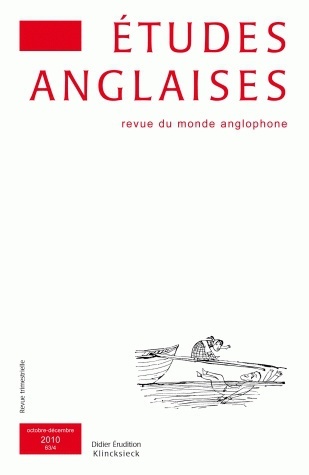Claire GALLIEN - Recycling the Orient in Eighteenth-Century British Literature : The Case of Busiris by Edward Young
Eighteenth-century pseudo-oriental fictions were determined by a process of literary recycling involving the salvaging, subversion and recreation of oriental and pseudo-oriental material. This article focuses on the English playwright Edward Young who devised his play Busiris in 1719 by recycling the pseudo-oriental heroic drama template, by disguising propagandist discourse in fictional garb, and by salvaging ancient and modern orientalist scholarship. Though overlooked by contemporary critics, this last element of the recycling process is, I argue, funda-mental to understanding the creation and reception of pseudo-oriental texts during the Enlightenment, when knowledge was disseminated across fictions and reinvented by fiction. Accordingly, the first part of this article surveys the different elements belonging to the composition of the play. It then deals with the trans-formation of the three intersecting elements constituting it, namely orientalist scholarship, heroic drama and Hanoverian politics. This leads to showing how the drama was caught in a cycle of novelty, one where it was revisited and reinvented by literary critics and second-hand historians.
La fiction pseudo-orientale du XVIIIe siècle est déterminée par un procédé que l'on pourrait qualifier de recyclage littéraire, impliquant la récupération, la subversion et la recréation du matériau oriental et pseudo-oriental. La pièce Busiris écrite par Edward Young en 1719 n'échappe pas à la règle. En effet, l'auteur y exploite le modèle du drame héroïque pseudo-oriental afin de dissimuler un discours de propagande politique contre le Premier Ministre Robert Walpole. Ce faisant, le dramaturge dissémine des éléments de connaissance sur l'Égypte ancienne, qu'il modifie parfois pour les besoins de la pièce. Ce dernier élément, souvent ignoré par la critique littéraire, qui s'en tient aux questions de propagande, est fondamental pour comprendre les processus de création et de réception du drame pseudo-oriental. Ainsi, dans un premier temps, nous examinerons les sources érudites qui sont entrées dans la composition de la pièce. La deuxième partie aborde la question de la conjonction entre drame héroïque, politique hanovrienne et érudition orientale. Enfin, une étude du recyclage de la pièce elle-même par la critique littéraire et les historiens de seconde main constitue la dernière partie de cet article.
Céline SABIRON - Places in Translation in Walter Scott's The Heart of Mid-Lothian
The Heart of Mid-Lothian is Walter Scott's novel of mobility. The protagonist Jeanie Deans travels from the "terra firma" (IV, 4: 371) of her family cottage in southern Scotland, to London, and eventually to the Island of Roseneath in the Scottish Highlands where she settles. The whole of Great Britain is therefore pictured by the author-cum-geographer who tries to draw as objective and accurate a chart of places as possible. Yet, the translation of verbal maps into geographical ones only leads to a pseudo-translation as places prove unmappable. Jeanie's Scottish place of residence seems to follow her wherever she travels, as if it were “transplanted” (IV, 6: 380) or, more precisely, translated. Ungraspable and unfixable, places are transferred from the real to the imaginary where space and time are changeable and deformable at will through the imagination of the narrator, the characters and the reader.
The Heart of Mid-Lothian se présente comme le roman de la mobilité. La protagoniste Jeanie Deans quitte la « terre ferme » (IV, 4: 371), c'est-à-dire sa maison familiale dans le sud de l'Écosse pour se rendre à Londres, puis à l'île de Roseneath dans les Hautes Terres écossaises où elle finit par s'installer. Une grande partie de la Grande-Bretagne est ainsi dépeinte par l'auteur-apprenti géographe qui essaie de tracer une carte aussi objective que précise des lieux rencontrés. Cependant, la traduction de ces cartes littéraires en cartes géographiques ne débouche que sur une pseudo-traduction dans la mesure où les lieux se montrent incartographiables. La résidence de Jeanie semble se déplacer avec elle, comme si elle était « transplantée » (IV, 6: 380) ou, pour être plus précis, translatée. Impossibles à saisir ou à figer, les lieux sont transférés du réel à l'imaginaire où l'espace et le temps sont changeables et déformables à souhait grâce à la puissance de l'imagination du narrateur, des personnages et du lecteur.
Frédéric REGARD - John Ross, explorateur loufoque : analyse socio-rhétorique d'un cas de discrédit
John Ross présente le profil d'un officier naval britannique à la réputation contrastée. On tente ici une lecture socio-rhétorique de son récit, Exploring Baffin's Bay (1819), en montrant d'abord de quelle manière le texte produit des images implicites de soi et de l'autre. À partir des notions d'« habitus » et de « champ » élaborées par Pierre Bourdieu, la rhétorique de Ross est ensuite replacée dans son contexte sociologique, celui des « worthy officers » de l'Amirauté, dont les codes auront été mal interprétés par ce simple marin écossais.
John Ross offers a contrasted image as a British naval officer. I attempt to read Ross's narrative of his adventures, Exploring Baffin's Bay (1819), from a socio-rhetorical perspective, showing first how his text implicitly produces images of the self and of the other. Drawing on Pierre Bourdieu's notions of 'habitus' and ‘field,' I then replace the explorer's rhetoric in its sociological context, that of the Admiralty's ‘worthy officers,' the codes of which seem to have been misconstrued by the simple Scottish seaman.
Richard PEDOT - « 49 Bard Road » : le mythe shakespearien dans Wise Children d'Angela Carter
Angela Carter installe son dernier roman, Wise Children, sur l'envers du mythe shakespearien, tel qu'incarné par la dynastie Hazard qui ont dominé la scène victorienne comme des géants tragiques. Ce qui est visé, cependant, n'est pas une simple réhabilitation du monde des bâtards et de la comédie. Si la comédie, par inversion, dissipe l'illusion tragique et réaliste, c'est en s'y sachant partie prenante. Au bout du compte, ce roman se lit comme une défense et illustration du pouvoir paradoxal de l'illusion, entre tragédie et comédie, de nous mettre en rapport avec le réel : une invitation à accepter allègrement ce qui est.
Wise Children, Angela Carter's last novel, is set on the wrong side of the Shakespearian myth, as embodied by the Hazard dynasty, “those tragic giants of the Victorian stage.” The point, however, is not merely to “stand up for bastards” and comedy. If comedy, on the other side of the tracks, dispels the tragic and realistic illusion, it is in full awareness of its own involvement in the same. Eventually, Wise Children reads as an apology for illusion and its paradoxical power, inbetween tragedy and comedy, to put us in touch with reality, inviting us gleefully to accept what is.
Érik MARTINY - Aurora's Avatars: A Generic Approach to Modern Dawn Poetry
This essay takes a look at dawn poetry to examine its ancestral lineage and the degree to which it connects with medieval formulations, and Renaissance reconfigurations, of the genre. It lays emphasis on the eminence of Philip Larkin's “Aubade” in the recent history of dawn poetry, without lending it undue significance as it is ultimately not without precedence and cannot be said to have permanently inflected its course.
Cet article étudie la poésie consacrée à l'aube afin d'explorer sa filiation ancestrale et de déterminer dans quelle mesure ses avatars modernes se rattachent aux formulations médiévales ainsi qu'aux réécritures du genre à la Renaissance. Il place l'“Aubade” de Philip Larkin au cœur de l'évolution récente de la poésie matinale tout en considérant que le poème n'est pas sans antécédent et n'a pas détourné le cours du genre de manière durable.
Kevin Mendousse - De la vertu préventive des logatomes contre le parasitage lexico-sémantique
Les années 60 ont vu naître la théorie taylorienne de la réminiscence lexicale du symbolisme phonétique, théorie qui remet en question la vertu préventive des logatomes — traditionnellement tenue pour acquise depuis Sapir — contre le parasitage lexico-sémantique dans les jugements perceptifs des locuteurs. Rares, pourtant, sont les linguistes à s'être interrogés sur le bien-fondé d'un tel renouvellement épistémologique. C'est ce que nous faisons ici en revenant sur cet épisode de l'histoire du symbolisme phonétique. En montrant comment l'hypothèse de la réminiscence lexicale du symbolisme phonétique ne va pas de soi, le présent article cherche à légitimer le recours expérimental aux logatomes.
The 1960s saw the emergence of the Taylorian lexical feedback theory of phonetic symbolism, a theory that calls into question the preventive value of non-words— which has traditionally been taken for granted since Sapir—in terms of lexico-semantic interferences in speakers' perceptual judgements. Few linguists, however, have investigated the soundness of this epistemological reappraisal. This paper revisits this chapter in the history of phonetic symbolism. By demonstrating that the lexical feedback theory of phonetic symbolism is not a given, I seek here to legitimatize the experimental use of non-words.




